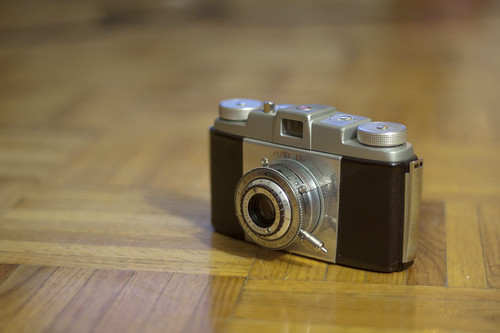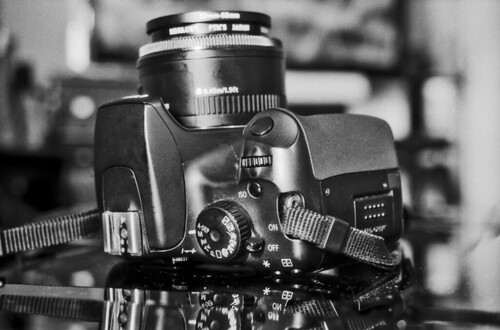 This
little gem of a camera I got when I picked up a box of Kodak cameras.
From a 126 Instamatic, to Brownies, and other various folders. I
actually got two of these little babies. The thing is, only one works.
The other camera only seems to work at 1/300s, while all the other
speeds are frozen, which is too bad.
This
little gem of a camera I got when I picked up a box of Kodak cameras.
From a 126 Instamatic, to Brownies, and other various folders. I
actually got two of these little babies. The thing is, only one works.
The other camera only seems to work at 1/300s, while all the other
speeds are frozen, which is too bad. This is a fun camera to use, and goes by "Scale Focusing" where you set the focus distance on the front element ring, set your Aperture, shutter speed, cock the shutter, and release. Very simple operation, and very light in hand.
 The
simple design means that they could mass produce these cameras with very
little cost involved. The Anaston 3-element coated lens is actually
very sharp, and provides good colour rendering, and contrast. Wide-open
it is quite soft, but is fairly sharp toward the center of the lens.
At ƒ/8 the lens really comes into its element, pardon the pun, and is
very sharp. The shutter operation is very simple, and is set by turning
the ring behind the front lens element which sets the shutter speed
from 1/25, 1/50, 1/100, 1/300, or Bulb. The flash connection is a
Kodak off-camera SYNC connection with an adapter for a standard
PC-connector, which is shown in these photos. The left side of the
camera holds the film cartridge, as well as the re-wind knob. Beside
the rewind is the Film Identification wheel, but the films listed on the
wheel are long since discontinued, but have Kodachrome, Royal Pan-X,
etc. Located on the right side of the camera is the take up
spool, film advance knob, film frame counter and indicator, and shutter
release button. When you take a photo, you cock the shutter, which is a
lever located on the left side of the lens, above the flash sync
connector, then press the shutter release when you have your photo
composed and focused. After taking the photo, you still cannot advance
the film until, like on the Argus cameras, you press a lever, located on
the back left, which allows you to advance to the next frame on the
film. This is not double exposure prevention, but prevents you from
accidentally winding passed the next frame. If you decide to, you can
take as many photos as you'd like on the same frame just by re-cocking
the shutter, and releasing it.
The
simple design means that they could mass produce these cameras with very
little cost involved. The Anaston 3-element coated lens is actually
very sharp, and provides good colour rendering, and contrast. Wide-open
it is quite soft, but is fairly sharp toward the center of the lens.
At ƒ/8 the lens really comes into its element, pardon the pun, and is
very sharp. The shutter operation is very simple, and is set by turning
the ring behind the front lens element which sets the shutter speed
from 1/25, 1/50, 1/100, 1/300, or Bulb. The flash connection is a
Kodak off-camera SYNC connection with an adapter for a standard
PC-connector, which is shown in these photos. The left side of the
camera holds the film cartridge, as well as the re-wind knob. Beside
the rewind is the Film Identification wheel, but the films listed on the
wheel are long since discontinued, but have Kodachrome, Royal Pan-X,
etc. Located on the right side of the camera is the take up
spool, film advance knob, film frame counter and indicator, and shutter
release button. When you take a photo, you cock the shutter, which is a
lever located on the left side of the lens, above the flash sync
connector, then press the shutter release when you have your photo
composed and focused. After taking the photo, you still cannot advance
the film until, like on the Argus cameras, you press a lever, located on
the back left, which allows you to advance to the next frame on the
film. This is not double exposure prevention, but prevents you from
accidentally winding passed the next frame. If you decide to, you can
take as many photos as you'd like on the same frame just by re-cocking
the shutter, and releasing it.Once the film is finished, there is a tab beside the film advance switch, which you must hold in, and believe me it really sucks to hold it in, and rewind the film back into the canister.
Once the film is rewound, you slide down the locking lever on the right side of the camera, and the entire back comes off so you can remove the film canister or load a new one.
The camera itself is lightweight, and made almost entirely of Bakelite plastic, with some metal around the lens mount for stability.
The camera does have a very lovely Ever-Ready (I say Never-Ready) leather case, which is quite attractive, and gives the camera an even more "timey" feel to it.
 |
| "Chain Monkies" - Kodak Pony 135 C Kodak Anaston 44mm ƒ/3.5 ORWO UN54+ 100ASA Film Kodak HC-110 (B) - 11:00 |
So check them out!
Quick Tech Specs;
Kodak Pony 135 Model C
Kodak Anaston 44mm ƒ/3.5 Triplet Lens
35mm Film Camera (Frame size 24x36mm)
Kodak Flash-300 Shutter. 1/25s - 1/300s +B
Scale Focusing Camera w/focusing as close as 2.5'
If you have one of these cameras, or another film camera, check out the Film Photography Project anyway, as they have film for that camera for sale, and have some of the best prices for Kodak Film!
Heck, you can even buy a camera from them.
Whether it's 35mm, 110, 120, or even Instant! They sell both the camera, and the film!
Check them out today!
Until next time, keep those shutters firing!


